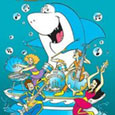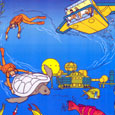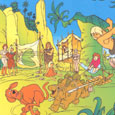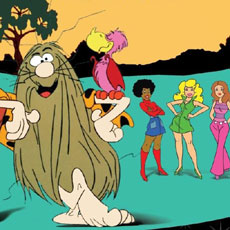Hanna-Barbera (1976), Warner Archive (February 15, 2011), 4 discs, 336 mins, 1.33:1 ratio, Dolby Digital 1.0, Not Rated , Retail: $29.95
Storyboard:
A shark and his fellow pop rockers defend the sea against perils of the deep… in the future!
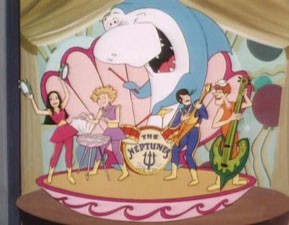
The Sweatbox Review:
Jabbajabbajabbajabbajabbajabbajaw!!!!…. Dang, I’ll never get that theme song out of my head.
Ah, the 1970s, home of the Scooby-Doo clones. It was an amazing time for networks to place orders for show after show about teenagers solving crimes alongside their pets, often with song sequences. Most of these clones were actually produced by Scooby’s own studio, Hanna-Barbera, and some actually hewed pretty close to the source material. Goober And The Ghost Chasers, for example, mainly differed from Scooby-Doo in that the cowardly dog turned invisible when scared. Other series had wider-ranging premises— featuring a huge family of Chinese kids, a sentient car, a ghost, etc.; but one show had the audacity to have the pet be a shark, touring with a rock band under the sea— in the future, yet! That’s pretty wacky, to be sure.
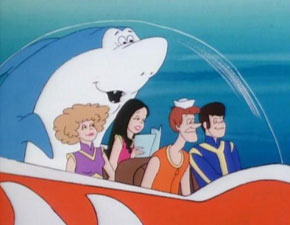
Jabberjaw was also part of the shark zeitgeist of the mid-1970s, led by Jaws and its imitators, though no other movie or TV show had a shark like this. Another main source of “inspiration” would be 1970’s Josie And The Pussycats, which had a similar premise (except for all the water). Jabberjaw was a great white shark that played drums (despite having, you know, no hands) for a rock band called The Neptunes. The other four members of the band were human, comprised of familiar types for those that had watched Scooby or Josie: reliable Biff (Fred or Alan, take your pick), haughty Shelly (Alexandra, or a much meaner Daphne), ditzy Bubbles (Melody), and the well-named Clamhead (the group’s Shaggy). The band toured under the sea in the future year of 2076, visiting numerous underwater cities, which somehow led them to encounter a wide variety of nefarious types and dastardly plans.

Character interplay played a large role in the scripts, with Shelly generally showing disdain for everyone, Biff playing the straight man, and everyone else acting a little goofy. Jabberjaw sounded a whole lot like Curly of The Three Stooges (thanks to Frank Welker), though his “I don’t get no respect” proclamations were more reminiscent of Rodney Dangerfield. The plots, though necessary, basically had to be moulded around the oddball personalities of the cast, and didn’t involve too much depth. Fortunately, I happen to like hackneyed mad scientist plots, so I found this series enjoyable.

Your basic episode introduces an evil bad guy, explaining to his minions what his plan is. We catch up with The Neptunes on their way to their latest gig in an exotic underwater city, modelled after an aboveground locale like the Middle East, Latin America, etc. The Neptunes run afoul of the evil bad guy, they contact the local authorities, they get captured by the evil bad guy, and then they escape to foil the evil bad guy’s plans, but naturally only after a musical chase sequence. They get congratulated by the local authorities, and play some music. Budda-boom, budda-bing. There’s your episode.
Plots are simple, silly, and great fun. See Dr. Lo hatch his plan to release a Gorgon on Aquahama! See Dorsal attempt to overthrow the queen of Atlantis! See Coldfinger try to take over the gold mines of Aqualaska! See Jabberjaw compete in the Aqualand rodeo! See The Piranha intercept a tanker bound for Amsteraqua! The structure of the stories stays quite uniform, but the details do cover a lot of ground.

The fun, of course, comes not only from the crazy plots and character interplay (which gets admittedly repetitive), but also from seeing what the Hanna-Barbera artists come up with. The scripts might have been simplistic, but they still offered enough invention for the H-B staff to come up with lots of underwater (and futuristic) sight gags, and tremendous lairs for a colourful assortment of villains. Defying the weak animation, the excellent backgrounds save the show from visual boredom, allowing Jabberjaw to look like a first-class TV cartoon production.
It’s all pretty much typical 1970s Hanna-Barbera hokum, but really— in a show about future teens and their shark foiling supervillain schemes, what’s not to love?

Is This Thing Loaded?
There are no special features on this release. The menu is a pretty bland affair, offering only episode numbers and no title cards.
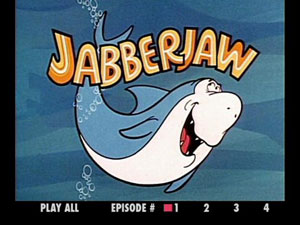
Case Study:
The four single-layer DVD-R discs each hold four episodes and reside in double-sided trays in a standard sized clear keepcase. Warner Archive maintains consistency with the trade dress on their Hanna-Barbera releases, which I appreciate. The discs all have silk-screened art (the same on each disc), with episode titles. Chapter stops are provided every ten minutes.

Ink And Paint:
This show has not been remastered, so expect what you normally see on cable. The transfers are quite soft, and a tad faded, but at least the compression work is top-notch. Without restoration, this is the best the show can look. Prints are in decent shape, though you will see some dust on them.
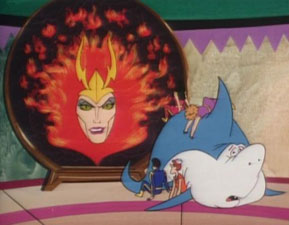
Scratch Tracks:
The mono audio offers the expected narrow range, but it’s all clear and just barely distorted. The Hanna-Barbera laugh track is there, but that’s not the fault of the DVD. There are no other language options, and no subtitles.

Final Cut:
Jabberjaw is not sophisticated, but it is fun. You likely won’t be tempted to watch too many episodes in a row, owing to repetition of plot structure, but the show makes a tasty snack. Maybe you have to be a child of the 1970s to truly appreciate the show on a nostalgic level, but my kids quite enjoyed watching this DVD set too. There is just something about that 1970s Hanna-Barbera vibe, a mix of limited animation, solid if simple scripts, and top-quality design work. Oh, and great voice actors, of course. Warner Archive put this out in a no-frills set, but the quality is passable. I’ll take my classic Hanna-Barbera any way I can get it. This is a nice addition to the old H-B library.
 | ||
 |


